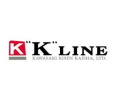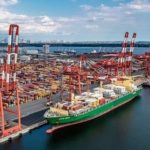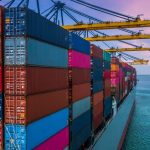1. Qualitative Information and Financial Statement
(1) Qualitative Information about the Consolidated Operating Result
Due to significant business performance improvement of OCEAN NETWORK EXPRESS PTE. LTD, the company recorded 573.6 billion yen of equity in earnings of unconsolidated subsidiaries and affiliates for the consolidated cumulative third quarter. Within the recorded equity in earnings of unconsolidated subsidiaries and affiliates, “ONE” accounted for 567.0 billion yen in the cumulative third quarter, and 72.5 billion yen in the third quarter alone.
Performance per segment was as follows.
(i)Dry Bulk Segment
Dry Bulk Business
In the Cape-size sector, at the beginning of the quarter, as the vessel supply-demand balance tightened due to port congestion associated with COVID-19 control measures, market rates stayed high. However, in the middle of the quarter through the end of the year, market rates declined while showing some fluctuations as a result of the weakening of the impact of those measures and a decrease in demand for China-bound transportation. In the medium and small vessel sector, market rates declined because of the effects of the easing of port congestion in China as well as a decline in demand for the transportation of coal to India and of steel products to Europe, which supported the market early in the quarter. However, the market stayed generally firm, supported mainly by an increase in demand for the transportation of grains to China. Under these circumstances, the Group strived to manage the market exposures appropriately and reduce operation costs and improve vessel operation efficiency.
As a result, the overall Dry Bulk Segment recorded a year-on-year increase both in revenue and profit
(ii)Energy Resource Transport Segment
LNG Carrier, Electricity Business, Tanker Carrier and Offshore Business
Concerning LNG carriers, thermal coal carriers, large crude oil tankers (VLCCs), LPG carriers, drillship and FPSO (Floating Production, Storage and Offloading system), the business stayed firm for mid- and long-term charter contracts and contributed to secure stable profit. As a result, the overall Energy Resource Transport Segment recorded a year-on-year increase both in revenue and
profit.
(iii) Product Logistics Segment
Car Carrier Business
In the global car sales market, production and shipments in some regions were affected by supply shortages of semiconductors and auto parts and the Russia-Ukraine situation, but the recovery from the impact of the COVID-19 continued. Meanwhile, the Group continued efforts to restore freight rates to the former levels and improve operational efficiency.
Logistics Business
In the domestic logistics and port business, although domestic container handling volume was on a downtrend with respect to shipments to China, overall volume remained similar to the level in the same quarter of the previous year. In the towage business and the warehousing business, work volume stayed firm. As for the international logistics sector, the downtrend in ocean and air cargo transportation demand continued in the forwarding business. In the finished vehicle transportation business, both land transportation volume and storage volume declined due to volume adjustment for vehicles bound for Australia.
Short Sea and Coastal Business
In the short sea business, although coal transportation volume declined year-on-year due to the Russia-Ukraine situation, the overall market remained firm because of robust demand for the transportation of steel products and biomass fuels. In the coastal business, the recovery in the numbers of passenger cars and passengers transported continued as a result of the lifting of restrictions on activities associated with the COVID-19, and cargo transportation volume also increased year-on-year.
Containership Business
Since the third quarter, transportation demand and short-term freight market conditions were sluggish due to an increase in commodity inventories in consuming regions, mainly in Europe and the U.S., and a decline in consumer confidence due to inflation. However, the business performance of “ONE” improved year-on-year by the results of the first half of the year.
As a result, the overall Product Logistics Segment recorded a year-on-year increase in both revenue and profit.
Other
Other includes but not limited to the Group’s ship management service, travel agency service, and real estate and administration service. The segment recorded a year-on-year increase in both revenue and profit.
(2) Qualitative Information on the Consolidated Financial Situation
Consolidated assets at the end of the consolidated 3rd Quarter of this fiscal year were ¥2,089.3 billion, an increase of ¥514.3 billion from the end of the previous fiscal year as a result of an increase in investment securities and other factors.
Consolidated liabilities decreased by ¥65.4 billion to ¥524.7 billion as a result of a decrease in short-term loans and current portion of long-term loans and other factors compared to the end of the previous fiscal year. Consolidated net assets were ¥1,564.6 billion, an increase of ¥579.7 billion compared to the end of the previous fiscal year as a result of an increase in retained earnings and other factors.
(3) Qualitative Information on the Consolidated Prospects for FY2022
In the Dry Bulk Segment, market rates declined in the second half due to a multitude of uncertainties, including concerns over global inflation and recession and the timing of normalization of economic activity in China. However, market rates are expected to remain above a certain level because of an increase in demand for coal transportation due to the Russia-Ukraine situation and the tightening of the vessel supply-demand balance due to limited building of new ships. The Group will watch out for changes in transportation demand and trade patterns and make preparations to promptly respond. At the same time, amid growing need to deal with environmental problems, take advantage of its strength in high quality transportation, the Group will strive to secure stable profit by increasing vessel operation efficiency and reducing costs as well as increasing mid- and long-term contracts.
In the Energy Resource Transport Segment, the Group will continue efforts to secure stable profit as it expects to ensure smooth business operations, supported by mid- and long-term contracts, with respect to LNG carriers, thermal coal carriers, large crude oil tankers (VLCCs), LPG carriers, drillships, and FPSO (Floating Production, Storage and Offloading systems).
As for the Product Logistics Segment, regarding the car carrier business, while there are concerns over the impacts of shortages of semiconductors and auto parts, the continued inflationary trend, and the possible recession, mainly in the United States and Europe, the Group will continue to strive to improve operational efficiency through such measures as appropriate fleet restructuring and reorganization of the network of trades in addition to restoring freight rates to the former levels. In the logistics business, while the Group will keep a close watch on the negotiations over North American West Coast port labor-employer contracts, domestic container handling volume is expected to remain firm. As for the international logistics sector, as a result of a decline in ocean and air transportation, market rates have recently remained on a downtrend in the forwarding business. In the finished vehicle transportation business, handling volume is expected to increase due to continued robust demand for imported vehicles in Australia. In the containership business, recovery of transportation demand and short-term freight market conditions will take time, and the recovery in the current fiscal year is expected to be modest due to seasonal factors such as the Chinese New Year holiday in the fourth quarter. “ONE” will closely monitor the economic environment and strive for steady business operations while implementing measures to adapt to changes in supply and demand.
The Company’s important management task is to maximize returns to our shareholders by maintaining awareness of optimal capital structure at any time, always ensuring capital efficiency, financial soundness, and strategically allocating our management resources to investments in order to improve our financial strength considering mid to long-term business environment.
Based on this basic policy, regarding dividend for the fiscal year ending March 31, 2023, the Company plans payment of a year-end dividend of 300.00 yen per share which increased by 200.00 yen per share of prior forecast. Above will be implemented subject to the resolution at the Ordinary General Meeting of Shareholders scheduled in June 2023.
Source: Hellenic Shipping News






